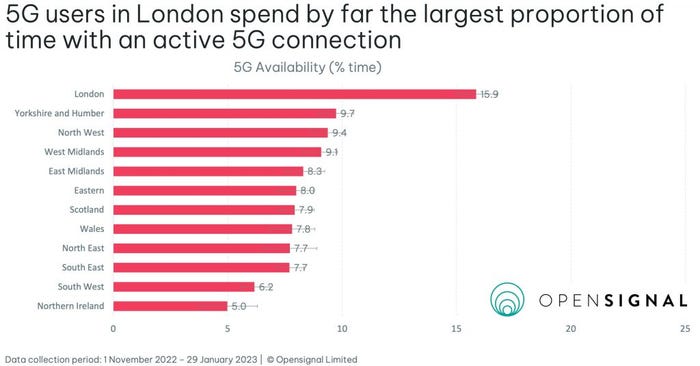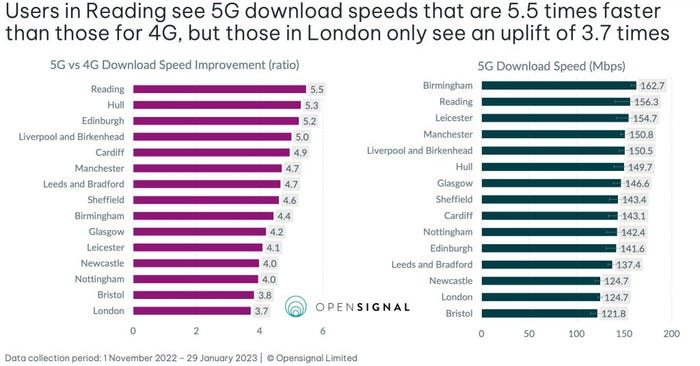Maybe it's because you're a Londoner that 5G's not much faster
The increase in download speed on 5G compared to 4G is less pronounced in London than in any other part of the UK.
March 16, 2023

The increase in download speed on 5G compared to 4G is less pronounced in London than in any other part of the UK.
This is according to a new report by network testing specialist Opensignal. Reading comes out on top, with 5G improving average download speed by a factor of 5.5, compared to London’s lowly 3.7.
Opensignal qualified its assertions by pointing out that London enjoys average 4G speeds of 33.6 Mbps – towards the high end of the range across the UK – which goes some way to explaining why the improvement offered by 5G isn’t quite so impressive. But that only goes some way to explaining it. Leicester, for instance, has the highest average 4G speed according to Opensignal’s tests (37.8 Mbps), but 5G still manages to improve on it by a factor of 4.1.
In addition, the report shows 5G speeds in London average 124.7 Mbps, which puts the capital second from bottom of the table. Birmingham sits on top with 162.7 Mbps, and aforementioned Leicester is third with 154.7 Mbps.
Regional comparisons present a similar picture. Scotland and Wales are tied for first place with an improvement factor of 5.1, while London ranks comfortably last, coming in behind Eastern England which scores 4.2.
Even those living in rural areas see a greater improvement (4.7x) than Londoners when they switch from 4G to 5G.
What this suggests is that consumers keen to experience a ‘proper’ upgrade from 4G to 5G should avoid London at all costs. However, there is more to it than that.
London comes first – by some margin – when it comes to 5G availability. In Opensignal’s test, users in London have an active 5G connection for 15.9% of the time. On a regional basis, the next best place to live if you want as consistent a 5G connection as possible is Yorkshire and Humber, which scores 9.7%. Northern Ireland seems to have the patchiest coverage, ranking last with 5%.
It means that while users living outside London will generally enjoy a greater improvement in speed when they switch to 5G, they will get experience that improvement less often.
So, where does that leave us? Sadly, it leaves us feeling fairly uninspired. It is coming up to four years since the first 5G network went live in the UK, and the picture painted by Opensignal’s report features decidedly mediocre download speeds, and not particularly widespread coverage.
Why should the average punter take on the cost of a 5G smartphone today, when they can expect only a modest improvement in connection speed, provided they are lucky enough to be within reach of a mast? The second question is, what services – other than mobile broadband – can be accessed with a 5G connection today that can’t be accessed with a 4G connection? What is the justification for the outlay?
Rival test and measurement firm Ookla noted last month that several major 5G markets are seeing declines in median download speeds, and falling customer satisfaction. With the way things are not progressing, it seems the telecoms industry has a salvage job on its hands.


Get the latest news straight to your inbox. Register for the Telecoms.com newsletter here.
About the Author(s)
You May Also Like








.png?width=300&auto=webp&quality=80&disable=upscale)


_1.jpg?width=300&auto=webp&quality=80&disable=upscale)


.png?width=800&auto=webp&quality=80&disable=upscale)